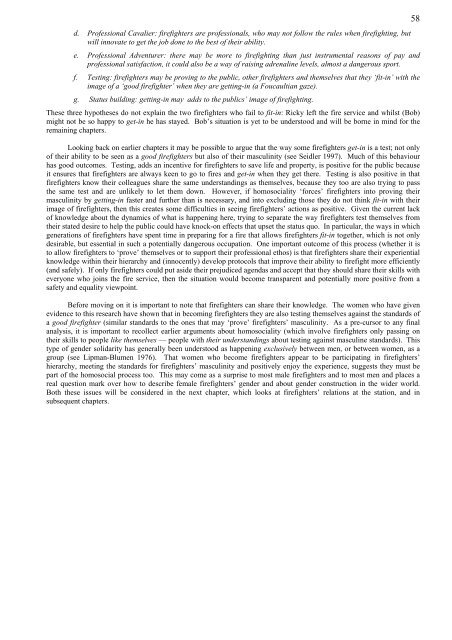One more last working class hero
One more last working class hero
One more last working class hero
You also want an ePaper? Increase the reach of your titles
YUMPU automatically turns print PDFs into web optimized ePapers that Google loves.
d. Professional Cavalier: firefighters are professionals, who may not follow the rules when firefighting, but<br />
will innovate to get the job done to the best of their ability.<br />
e. Professional Adventurer: there may be <strong>more</strong> to firefighting than just instrumental reasons of pay and<br />
professional satisfaction, it could also be a way of raising adrenaline levels, almost a dangerous sport.<br />
f. Testing: firefighters may be proving to the public, other firefighters and themselves that they ‘fit-in’ with the<br />
image of a ‘good firefighter’ when they are getting-in (a Foucaultian gaze).<br />
g. Status building: getting-in may adds to the publics’ image of firefighting.<br />
These three hypotheses do not explain the two firefighters who fail to fit-in: Ricky left the fire service and whilst (Bob)<br />
might not be so happy to get-in he has stayed. Bob’s situation is yet to be understood and will be borne in mind for the<br />
remaining chapters.<br />
Looking back on earlier chapters it may be possible to argue that the way some firefighters get-in is a test; not only<br />
of their ability to be seen as a good firefighters but also of their masculinity (see Seidler 1997). Much of this behaviour<br />
has good outcomes. Testing, adds an incentive for firefighters to save life and property, is positive for the public because<br />
it ensures that firefighters are always keen to go to fires and get-in when they get there. Testing is also positive in that<br />
firefighters know their colleagues share the same understandings as themselves, because they too are also trying to pass<br />
the same test and are unlikely to let them down. However, if homosociality ‘forces’ firefighters into proving their<br />
masculinity by getting-in faster and further than is necessary, and into excluding those they do not think fit-in with their<br />
image of firefighters, then this creates some difficulties in seeing firefighters’ actions as positive. Given the current lack<br />
of knowledge about the dynamics of what is happening here, trying to separate the way firefighters test themselves from<br />
their stated desire to help the public could have knock-on effects that upset the status quo. In particular, the ways in which<br />
generations of firefighters have spent time in preparing for a fire that allows firefighters fit-in together, which is not only<br />
desirable, but essential in such a potentially dangerous occupation. <strong>One</strong> important outcome of this process (whether it is<br />
to allow firefighters to ‘prove’ themselves or to support their professional ethos) is that firefighters share their experiential<br />
knowledge within their hierarchy and (innocently) develop protocols that improve their ability to firefight <strong>more</strong> efficiently<br />
(and safely). If only firefighters could put aside their prejudiced agendas and accept that they should share their skills with<br />
everyone who joins the fire service, then the situation would become transparent and potentially <strong>more</strong> positive from a<br />
safety and equality viewpoint.<br />
Before moving on it is important to note that firefighters can share their knowledge. The women who have given<br />
evidence to this research have shown that in becoming firefighters they are also testing themselves against the standards of<br />
a good firefighter (similar standards to the ones that may ‘prove’ firefighters’ masculinity. As a pre-cursor to any final<br />
analysis, it is important to recollect earlier arguments about homosociality (which involve firefighters only passing on<br />
their skills to people like themselves — people with their understandings about testing against masculine standards). This<br />
type of gender solidarity has generally been understood as happening exclusively between men, or between women, as a<br />
group (see Lipman-Blumen 1976). That women who become firefighters appear to be participating in firefighters’<br />
hierarchy, meeting the standards for firefighters’ masculinity and positively enjoy the experience, suggests they must be<br />
part of the homosocial process too. This may come as a surprise to most male firefighters and to most men and places a<br />
real question mark over how to describe female firefighters’ gender and about gender construction in the wider world.<br />
Both these issues will be considered in the next chapter, which looks at firefighters’ relations at the station, and in<br />
subsequent chapters.<br />
58
















